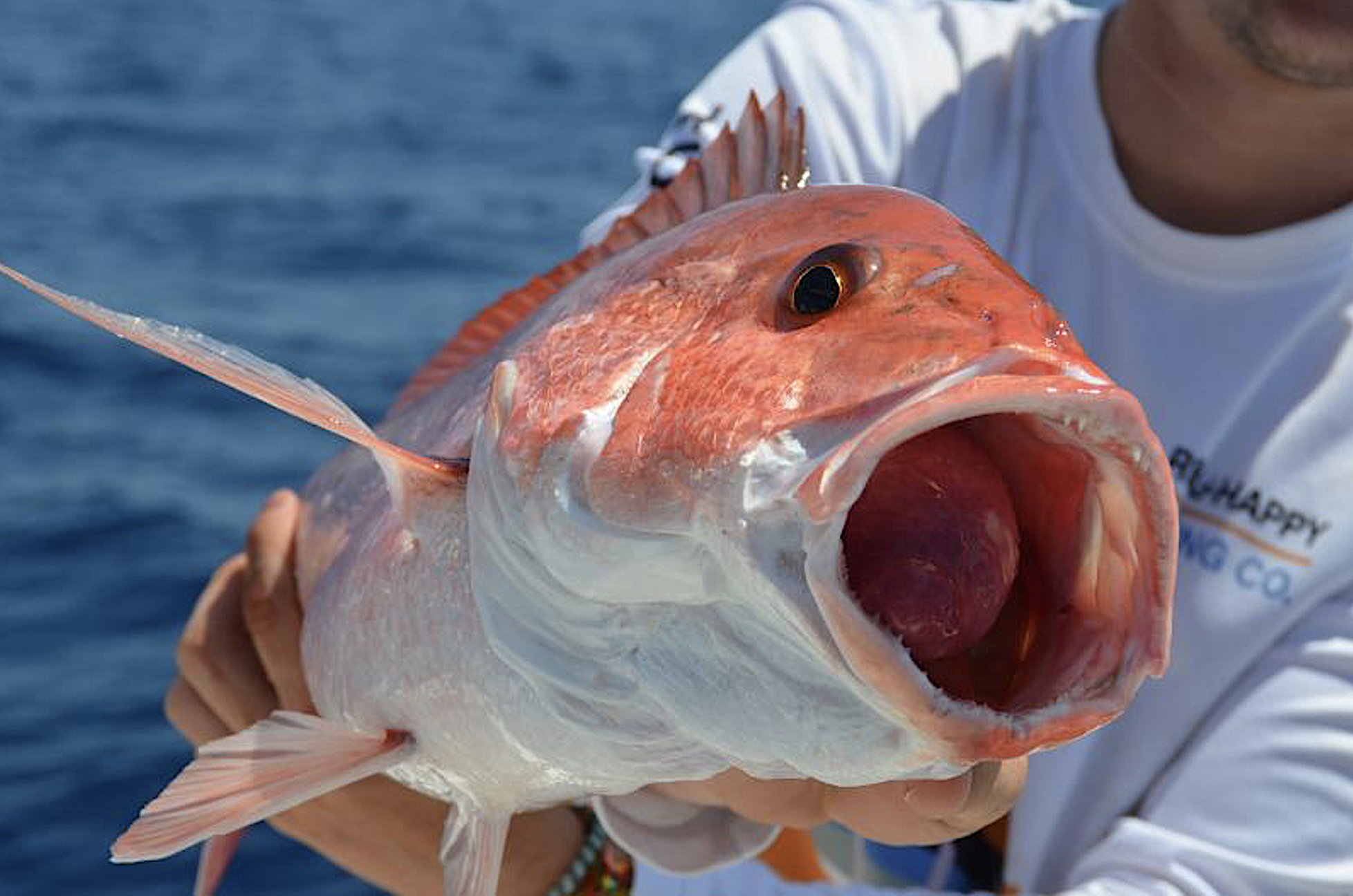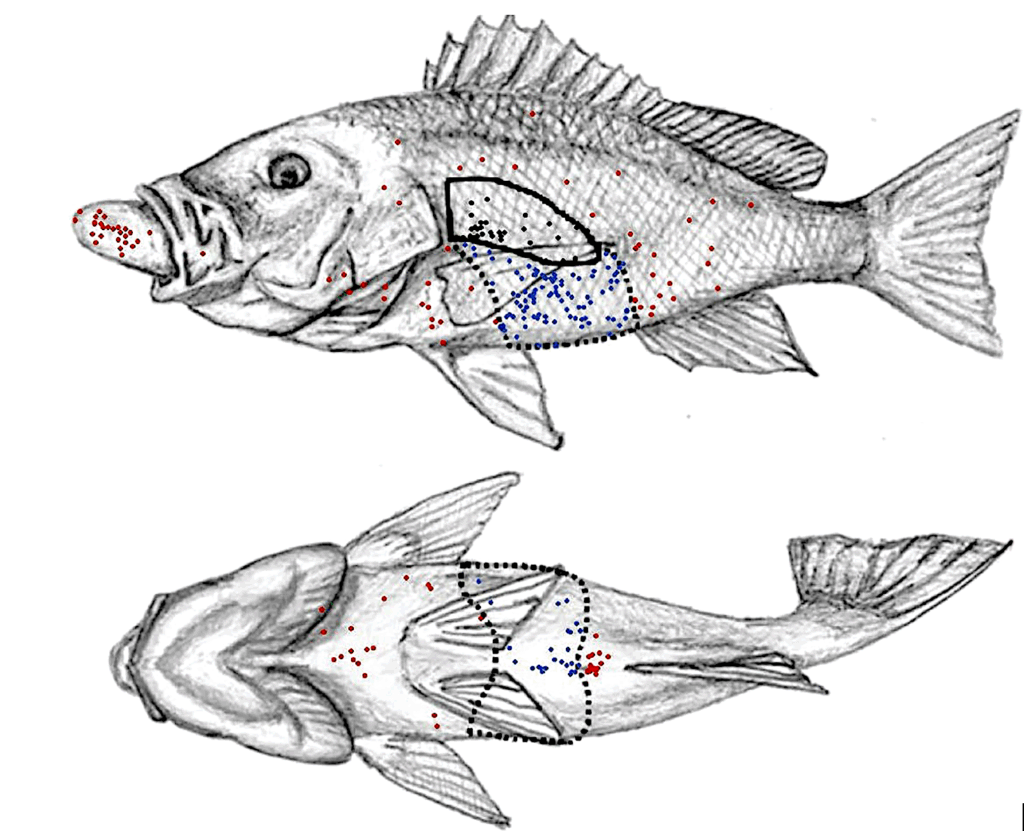Hook, Line & Science
Venting Deepwater Fish — and More

DO ANGLERS KNOW HOW TO VENT DEEPWATER REEF FISH?
Widespread misunderstandings may lead to unintentional harm.
Catch and release of reef fish in recreational fisheries can help maintain healthy fish populations, allowing more fish to survive and reproduce.
However, reef fish caught in deeper waters may not survive catch and release because of pressure trauma from surfacing too quickly. Just as SCUBA divers must ascend slowly to avoid injury, fish reeled up too quickly from deep waters can suffer internal damage from rapid pressure changes.
Descending devices can help safely return fish back to their original depths. In the U.S. South Atlantic, anglers fishing for snapper and grouper species (a.k.a. reef fish) must keep on board a descending device and a 16-ounce or heavier weight, rigged and ready for use. Descending devices can be costly and time-consuming for anglers to use when returning fish.
One quick and cost-effective solution for mitigating pressure trauma before release is venting. Venting involves gently inserting a small needle into a fish that has suffered pressure-related injuries, allowing trapped gas to escape the fish’s body. When applied properly, venting is an effective technique and can improve the fish’s survival after release.
But do recreational anglers know about venting, and more importantly, do they know how to vent properly to give released fish a fighting chance?
What did they study?
Researchers from NC State University and The Nature Conservancy surveyed headboat recreational anglers in North Carolina from April 2023 to January 2025 to better understand their knowledge about venting.
The team first asked anglers if they knew about venting. If anglers answered “yes,” researchers showed them sketches of a red snapper displaying pressure trauma symptoms. Then, anglers marked where they believed they should vent the fish. Researchers asked follow-up questions to see if prior experience with venting or private boat fishing influenced their knowledge.
Researchers categorized the marked locations as “proper,” “likely proper,” or “improper.” The “proper” region (the solid black line on the figure below) is best for venting and includes the swim bladder, accessed from the fish’s side. The “likely proper” region (the dashed black line) is similarly effective for venting and includes the area between the pelvic fins and anus.
Venting any other area is ineffective and harmful to the fish.

What did they find?
Researchers found that 59% of marine recreational headboat anglers had never heard of venting.
Of the 41% that knew about venting, 60% chose either a proper region to vent (black dots on the figure) or a likely proper region (blue dots). However, 40% of anglers who had heard of venting chose an improper region (red dots), such as an everted stomach (protruding from the mouth as a result of pressure trauma), the back muscles, or the anus.
What else did they find?
Prior experience with venting or private boat fishing did not affect an angler’s ability to identify the correct anatomical region for venting.
Notably, the research team conducted their surveys on a headboat, which typically hosts a large number of anglers (50+) on a large vessel with a captain and deckhands. Typically, deckhands often handle and release fish for novice anglers, so some patrons may have limited personal incentive to learn about venting. As a result, the lack of knowledge about venting among headboat anglers in this study may not reflect the broader recreational fishing community.
So what?
This research suggests that simply knowing about venting isn’t enough; anglers must also know how to apply it correctly for it to truly benefit fish stocks.
The lack of knowledge about proper venting hinders efforts to reduce fish mortality. At fishing access sites like docks or headboat boarding areas, where current materials are insufficient, the research team sees an urgent need for more accessible education campaigns about alleviating pressure trauma.
BY MADELINE PAYNE, communication fellow for Hook, Line & Science
full study
doi.org/10.1093/najfmt/vqaf032

WHAT HAPPENS TO ABANDONED, LOST, OR DISCARDED FISHING GEAR?
A new study suggests how much “ghost gear” might be out there.
Abandoned, lost, or discarded fishing gear is a source of pollution in both freshwater and saltwater environments worldwide. Research shows that this “ghost gear” can present multiple threats to plants and animals. For example, derelict gear can continue to fish and trap fish and other aquatic animals (“ghost fishing”).
However, research on the amount of ghost gear that actually exists is sparse.
“Magnet fishing” is a growing hobby worldwide that combines treasure hunting with environmental cleanup. A powerful magnet retrieves metal from the water, a method that also has potential to help locate ghost gear — and to estimate its prevalence in waterways.
What did they study?
Researchers from Hungary’s University of Debrecen, the Hungarian University of Agriculture and Life Sciences Change, and the HUN-REN Centre for Ecological Research analyzed posts from March 2016 to January 2023 in Facebook, Instagram, and YouTube groups dedicated specifically to magnet fishers sharing their catches.
The team categorized the post locations into flowing or standing bodies of water and the catch contents into six types of fishing gear: basic rod-and-reel parts, spinning rod setups, bottom bait feeding setups, nets, angling tools, and other gears. In total, the team identified and analyzed 2,889 posts.
What did they find?
Rivers contained more ghost gear than other bodies of water. Types of gear tended to differ by water body type, with more basic gear in oxbow lakes and fishing ponds and more bottom gear in lakes.
Spinning gear was more common in flowing waters than standing waters. The team found ghost gear in 330 (11.4%) posts and an average of 6.1 pieces of ghost gear in the posts that contained any fishing gear at all. Including all scanned posts, the team found an average of 0.7 pieces of fishing gear in each.
Anything else?
The few hundred locations included in the study, which hardly account for Hungary’s over 870,000 registered anglers, produced over 2,000 pieces of ghost gear. This means possibly hundreds of thousands of pieces of ghost gear are lurking in Hungary’s waters.
So what?
Although the study took place in Hungary, it exemplifies how magnet fishing has potential as a tool to address the problem of abandoned, lost or discarded fishing gear. Furthermore, it reveals that searching for gear in some locations may prove more profitable than in others.
BY RUTHIE FRONING, contributing editor for Coastwatch
full study: doi.org/10.1007/s10750- 023-05453-7
Read more at HookLineScience.com.


